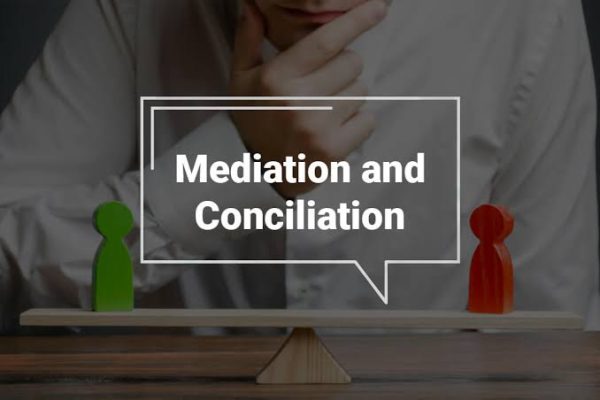
Mediation and Conciliation
Mediation and conciliation are both effective methods for resolving disputes, but they differ in their approach and level of third-party intervention.
When it comes to resolving disputes outside of the courts, mediation and conciliation stand out as particularly successful approaches. Although these names are frequently used synonymously, they have different meanings and methods. Let’s delve into the differences between mediation and conciliation, shedding light on their unique features and applications.
Mediation: Facilitating Communication and Agreement
Mediation is a structured negotiation process facilitated by a neutral third party, the mediator. The primary goal of mediation is to empower disputing parties to reach a mutually acceptable resolution. Here’s how mediation typically unfolds:
1. Neutral Mediator
The mediator serves as a neutral facilitator, guiding the conversation and fostering communication between the parties.
2. Voluntary Participation
Participation in mediation is voluntary, and the parties retain control over the outcome. They are free to explore various solutions and craft agreements tailored to their needs.
3. Confidentiality
Mediation proceedings are confidential, providing a safe space for parties to express their concerns openly.
4. Informal Setting
Unlike formal legal proceedings, mediation often takes place in a less adversarial and more collaborative setting.
5. Non-binding Outcome
The mediator does not impose decisions on the parties. Instead, they assist in generating options and help the parties arrive at a voluntary agreement.
Conciliation: Bridging Differences Through Intervention
Conciliation shares similarities with mediation but involves a more proactive role for the conciliator. Here are key distinctions:
1. Active Intervention
In conciliation, the conciliator takes a more active role in proposing solutions and encouraging compromise. While remaining impartial, the conciliator may offer suggestions and recommendations to facilitate agreement.
2. Formal Process
Conciliation often follows a more formalized process, with predefined stages and procedures.
3. Third-party Recommendations
Unlike mediation, where agreements are entirely voluntary, conciliation may involve the conciliator making recommendations for settlement if the parties cannot reach a consensus on their own.
4. Legal Framework
In some jurisdictions, conciliation may be governed by specific laws or regulations, adding a layer of legal oversight to the process.
Choosing the Right Approach
The decision to pursue mediation or conciliation depends on various factors, including the nature of the dispute, the preferences of the parties involved, and the desired level of third-party intervention. Here are some considerations:
Complexity of the Dispute
Mediation is well-suited for disputes where parties seek to preserve relationships and find creative solutions. Conciliation may be preferable for more contentious disputes requiring a structured approach.
Desire for Control
Parties who wish to retain maximum control over the outcome may favor mediation, while those seeking guidance and intervention may opt for conciliation.
Legal Requirements
In some cases, legal or contractual obligations may dictate the use of conciliation over mediation or vice versa.
In summary, while mediation and conciliation share common objectives of resolving disputes amicably, they differ in their approach, level of third-party intervention, and formalization. Understanding the distinctions between these two processes empowers parties to choose the most appropriate method for their specific circumstances, ultimately leading to more effective resolution outcomes. Whether through mediation or conciliation, the path to conflict resolution begins with open communication, empathy, and a commitment to finding common ground.
Frequently Asked Questions About Mediation and Conciliation
1. What is the main difference between mediation and conciliation?
Mediation and conciliation both involve the assistance of a neutral third party in resolving disputes, but the main difference lies in the level of intervention by the third party. In mediation, the mediator facilitates communication and assists the parties in reaching a voluntary agreement without imposing decisions. In conciliation, the conciliator takes a more active role, offering suggestions and recommendations, and may even propose settlement terms if the parties cannot reach an agreement on their own.
2. Are mediation and conciliation legally binding?
Mediation and conciliation are typically non-binding processes. This means that any agreements reached during the process are voluntary and require the consent of all parties involved to become legally enforceable. However, in some jurisdictions, there may be exceptions where agreements reached through mediation or conciliation can be made legally binding if certain conditions are met.
3. When should I choose mediation over conciliation, and vice versa?
The choice between mediation and conciliation depends on various factors, including the nature of the dispute, the preferences of the parties involved, and the desired level of third-party intervention. Generally, mediation is suitable for disputes where parties seek to preserve relationships and have more control over the outcome. Conciliation may be preferred for more complex or contentious disputes that require a structured approach and guidance from the conciliator.
4. How confidential are mediation and conciliation proceedings?
Confidentiality is a fundamental aspect of both mediation and conciliation. The discussions, proposals, and agreements made during the process are typically kept confidential to create a safe and open environment for the parties to negotiate. However, there may be exceptions to confidentiality, such as when disclosure is required by law or when there are concerns about safety or illegal activities.
5. What are the benefits of mediation and conciliation compared to litigation?
Mediation and conciliation offer several advantages over litigation, including cost-effectiveness, faster resolution times, greater control over the outcome, preservation of relationships, and confidentiality. These alternative dispute resolution methods also allow parties to explore creative solutions that may not be available in a courtroom setting, leading to more mutually satisfactory outcomes.

Leave a Reply